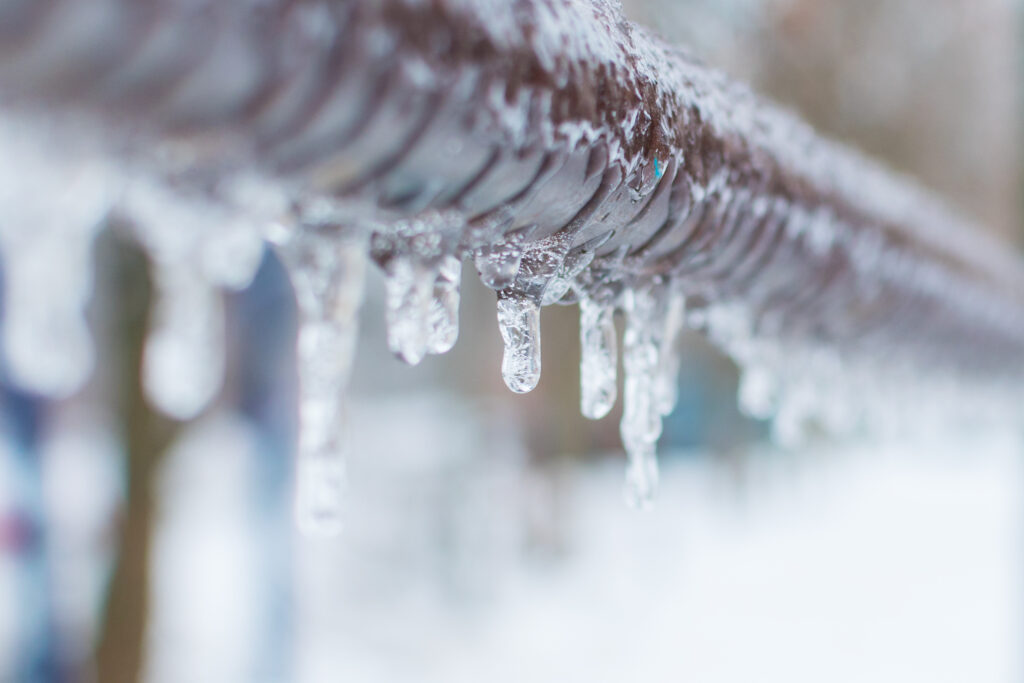What Temperature Do Pipes Freeze in Kendallville, and What to Do if It Happens

When winter descends upon Kendallville, Indiana, residents must brace themselves for the cold. While the snowflakes and crisp air can be beautiful, they also bring the risk of frozen pipes. Knowing the temperature at which pipes freeze and understanding how to respond if it happens can save you from costly repairs and headaches.
T&T Plumbing & Heating, Inc. explains when frozen pipes are a risk and what to do if your water pipes do freeze to prevent damage like a burst pipe. We’ll also share how you can prepare now to prevent frozen pipes this winter.
At What Temperature Can Pipes Begin to Freeze?
Water freezes at 32 degrees Fahrenheit, but the actual temperature at which pipes freeze can vary based on several factors:
Type of Pipe
Different materials react differently to cold weather and freezing temperatures. For instance, copper pipes are thin-walled and tend to freeze sooner than PVC pipes, which are thicker and less likely to freeze.
Insulation
Well-insulated pipes can withstand colder temperatures without freezing, as the insulation helps the pipe retain heat and withstand the cold air. Poorly insulated pipes are more susceptible to losing heat and freezing when the outdoor temperature dips.
Location of Pipes
Pipes located in unheated areas, such as basements, attics, or crawl spaces, are at a higher risk of freezing and bursting. Outdoor pipes and outdoor faucets are likely to freeze sooner than interior pipes. Additionally, pipes that are inside the house along exterior walls are more vulnerable to freezing than pipes close to more central areas of the home.
In Kendallville, IN, homeowners need to be mindful of the weather forecast throughout the winter. Monitor the forecast for cold temperatures and the conditions that freeze pipes. While pipes can freeze at 32 degrees, typically freezing begins when the outside temperature drops below 20 degrees Fahrenheit for a few hours or more, or during a sudden cold snap.
Signs That Your Pipes May Be Freezing
When freezing temperatures arrive, you need to be diligent about detecting the signs of frozen pipes. Here are some warning signs that your pipes may be freezing:
- No Water Flow: If you turn on a faucet and only a trickle or no water comes out, your pipes may be frozen.
- Frost on Pipes: Check for frost or ice on exposed pipes. If you notice ice forming, act quickly.
- Unusual Sounds: Listen for gurgling or hissing noises in your plumbing. This can indicate trapped air due to ice blockage.
- Temperature Drops: If the temperature dips significantly outside and your heating system struggles to keep up, your pipes could be at risk.
The sooner you can catch these signs in your home, the sooner you can take action. If you’re able to stop your pipes from freezing completely or thaw frozen pipes quickly, you can prevent burst pipes from causing water damage in your home and the need to call our plumbers for emergency pipe repairs and water line replacement.
What to Do if Your Pipes Freeze
If you suspect that your pipes are starting to freeze or have frozen completely during colder weather, don’t panic. Here are the steps to take to address the situation safely:
1. Locate the Frozen Section
Start by identifying the section of the pipe that is frozen. Check exposed pipes in areas that are unheated or poorly insulated, such as:
- Basements
- Attics
- Crawl spaces
- Outside walls
2. Turn Off the Water Supply
Before attempting to thaw the pipes, turn off the main water supply to prevent flooding and further damage to your home if the pipe bursts once it thaws.
3. Apply Heat Carefully
There are several safe methods to thaw frozen pipes:
- Hair Dryer: Use a hairdryer on a low setting to gently heat the affected area. Move the dryer back and forth, never leaving it in one spot for too long.
- Space Heater: If safe to do so, position a space heater near the frozen section to generate warmer air in the area. Make sure that it is away from flammable materials.
- Warm Towels: Soak towels in warm water and wrap them around the frozen pipe. This method takes longer but is effective.
Never use an open flame (like a blowtorch) or high-temperature sources that can damage the pipe.
4. Open Faucets
As you apply heat to the pipe, open the faucet connected to the frozen section. This will help relieve pressure and allow water to drain out once the ice begins to melt.
5. Monitor the Situation
Keep an eye on the area while you’re thawing the pipe. If you hear running water flowing within the pipe, that’s a good sign. However, if you notice any leaks, turn off the water supply immediately and call us to have a plumber fix your water pipes.
6. Call a Professional
If you’re unable to locate the frozen pipe or if your efforts to thaw it are unsuccessful, it’s time to call in the experts. T&T Plumbing & Heating, Inc. can resolve the issue quickly and efficiently, thawing your pipes and repairing any plumbing damage caused by burst pipes.
Tips to Prevent Frozen Pipes
While knowing what to do if your pipes freeze is vital, prevention is always the best bet. There are things you can do now to prepare for cold weather as well as strategies to protect your pipes from freezing when temperatures drop:
- Insulate Your Pipes: Wrap pipes in foam insulation sleeves, and pay special attention to those in unheated areas. This extra layer of protection can help maintain water temperature and make a significant difference in preventing freezing.
- Seal Cracks and Openings: Check for drafts around windows, doors, and areas where pipes enter your home. Sealing these gaps can help keep cold air from affecting your plumbing pipes inside.
- Let the Faucets Run: During extreme cold snaps, let your faucets drip slightly. The running water helps prevent pipes from freezing by keeping water inside them flowing through your plumbing system.
- Maintain a Consistent Temperature: Keep your thermostat set to a consistent temperature, even if you’re away from home. A steady environment can prevent pipes from freezing.
- Open Cabinet Doors: If you have plumbing in cabinets, especially in kitchens, bathrooms, and colder areas of the home, open the doors to allow warm air to circulate around the pipes.
- Disconnect Hoses: Make sure to disconnect all outdoor hoses and shut off the water supply to outdoor faucets. Any water left in the hoses or outdoor spigots can freeze and cause pressure buildup inside the pipes, leading to bursts.
Keep the Garage Door Closed: If you have water supply lines running through your garage, keeping the garage door closed can help retain warmth and protect those pipes from freezing.
Prevent Pipes From Freezing in Kendallville This Winter
Winter in Kendallville can be a wonderland, but it also comes with the responsibility of protecting your home from frozen pipes. By understanding the risks, recognizing the signs of freezing, and taking preventative measures, you can ensure your plumbing system remains intact.
If you encounter any issues with your plumbing once the temperatures drop, don’t hesitate to reach out to T&T Plumbing & Heating, Inc. for expert assistance. Your home’s plumbing is worth the care!




